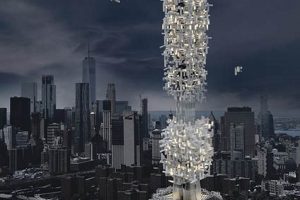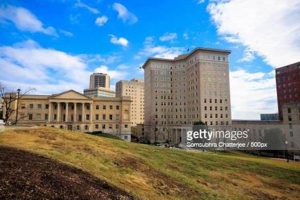New York City skyscrapers are among the most iconic and recognizable buildings in the world. They are a symbol of the city’s power, wealth, and ambition. The first skyscraper, the Equitable Life Building, was built in 1870, and since then, hundreds of other skyscrapers have been built in New York City. Today, the city is home to more than 6,000 skyscrapers, more than any other city in the world.
Skyscrapers have had a profound impact on the development of New York City. They have helped to create a dense, urban environment that is home to millions of people. They have also been a major factor in the city’s economic growth. Skyscrapers provide office space for businesses, and they attract tourists from all over the world. In addition, skyscrapers have helped to shape the city’s skyline, making it one of the most recognizable in the world.
The history of New York City skyscrapers is a story of innovation and ambition. The first skyscrapers were built using steel frames, which allowed them to be taller and stronger than previous buildings. In the early 20th century, skyscrapers began to be built with reinforced concrete, which made them even taller and more durable. Today, skyscrapers are built using a variety of materials, including glass, steel, and concrete. Skyscrapers are an important part of New York City’s history and culture. They are a symbol of the city’s power, wealth, and ambition. They have also had a profound impact on the development of the city, and they continue to be a major factor in its economic growth.
1. Height
The height of New York City skyscrapers is one of their most defining characteristics. The first skyscrapers were built in the late 19th century, and they were much shorter than the skyscrapers that we see today. However, as technology improved, skyscrapers began to get taller and taller. Today, the tallest skyscraper in New York City is One World Trade Center, which stands at 1,776 feet tall.
There are several reasons why New York City skyscrapers are so tall. First, the city’s limited land area means that buildings need to be built up rather than out. Second, the city’s dense population means that there is a high demand for housing and office space. Third, the city’s strong economy means that there is a lot of money available to invest in tall buildings.
The height of New York City skyscrapers has had a profound impact on the city. Skyscrapers have helped to create a dense, urban environment that is home to millions of people. They have also been a major factor in the city’s economic growth. Skyscrapers provide office space for businesses, and they attract tourists from all over the world. In addition, skyscrapers have helped to shape the city’s skyline, making it one of the most recognizable in the world.
2. Architecture
The architecture of New York City skyscrapers is as diverse as the city itself. Skyscrapers have been built in a variety of architectural styles, from neo-Gothic to Art Deco to modern. However, there are some common architectural features that are found in many New York City skyscrapers.
- Height: New York City skyscrapers are known for their height. The tallest skyscraper in the city is One World Trade Center, which stands at 1,776 feet tall.
- Setbacks: Many New York City skyscrapers have setbacks, which are required by law to allow for more light and air to reach the street level. Setbacks can create a distinctive stepped appearance, which is a common feature of New York City’s skyline.
- Facade: The facade of a skyscraper is the exterior surface of the building. New York City skyscrapers often have facades made of glass, metal, or concrete. The facade can be used to create a variety of visual effects, and it can also be used to reflect the building’s function or purpose.
- Spire: Many New York City skyscrapers have spires, which are tall, pointed structures that extend from the top of the building. Spires can be used to add height to a building, and they can also be used to create a distinctive look.
The architecture of New York City skyscrapers is constantly evolving. As new technologies are developed, architects are able to design taller and more innovative buildings. The future of New York City’s skyline is bright, and it is likely that we will see even more amazing skyscrapers in the years to come.
3. Construction
The construction of New York City skyscrapers is a complex and challenging process. It requires careful planning, coordination, and execution. Skyscrapers are built using a variety of materials, including steel, concrete, and glass. The construction process can take several years, and it often involves hundreds of workers.
- Planning: The first step in constructing a skyscraper is planning. This involves choosing a site, designing the building, and obtaining the necessary permits. The planning process can take several months or even years.
- Foundation: Once the plans have been finalized, the foundation of the skyscraper can be built. The foundation is the base of the building, and it is responsible for supporting the entire structure. The foundation of a skyscraper is typically made of concrete and steel.
- Structure: The next step is to build the structure of the skyscraper. The structure is the framework of the building, and it is responsible for supporting the weight of the building and its occupants. The structure of a skyscraper is typically made of steel.
- Facade: The facade is the exterior of the skyscraper. It is responsible for protecting the building from the elements and providing a weatherproof seal. The facade of a skyscraper is typically made of glass, metal, or concrete.
The construction of New York City skyscrapers is a complex and challenging process, but it is also a testament to the skill and ingenuity of the city’s architects and engineers. Skyscrapers are an important part of New York City’s skyline, and they continue to be a symbol of the city’s power and ambition.
4. History
The history of New York City skyscrapers is a story of innovation, ambition, and triumph. The first skyscrapers were built in the late 19th century, and they were much shorter than the skyscrapers that we see today. However, as technology improved, skyscrapers began to get taller and taller. Today, the tallest skyscraper in New York City is One World Trade Center, which stands at 1,
776 feet tall.
- The Early Years
The first skyscrapers were built in the late 19th century, and they were much shorter than the skyscrapers that we see today. However, these early skyscrapers were still a marvel of engineering, and they helped to change the way that people thought about buildings. The early skyscrapers were also a symbol of the city’s growing wealth and power.
- The Art Deco Era
The Art Deco era was a time of great prosperity in New York City, and this was reflected in the architecture of the city’s skyscrapers. Art Deco skyscrapers are characterized by their sleek lines, geometric shapes, and decorative details. Some of the most famous Art Deco skyscrapers in New York City include the Empire State Building and the Chrysler Building.
- The Post-World War II Era
After World War II, New York City experienced a period of rapid growth. This growth was fueled by the city’s strong economy and its position as a global financial center. The post-World War II era saw the construction of some of the tallest and most iconic skyscrapers in New York City, including the World Trade Center and the Bank of America Tower.
- The 21st Century
The 21st century has seen the construction of some of the most innovative and sustainable skyscrapers in New York City. These skyscrapers are designed to be environmentally friendly and to provide a comfortable and productive work environment for their occupants. Some of the most notable 21st-century skyscrapers in New York City include the One World Trade Center and the Hudson Yards complex.
The history of New York City skyscrapers is a story of innovation, ambition, and triumph. Skyscrapers have helped to shape the city’s skyline and have played a major role in its economic and cultural development.
5. Impact
New York City skyscrapers have had a profound impact on the city’s development. They have helped to create a dense, urban environment that is home to millions of people. They have also been a major factor in the city’s economic growth. Skyscrapers provide office space for businesses, and they attract tourists from all over the world. In addition, skyscrapers have helped to shape the city’s skyline, making it one of the most recognizable in the world.
- Economic Impact
Skyscrapers have had a major impact on the New York City economy. They provide office space for businesses, and they attract tourists from all over the world. Skyscrapers have also helped to create jobs and boost the city’s tax base.
- Social Impact
Skyscrapers have had a significant impact on the social fabric of New York City. They have helped to create a dense, urban environment that is home to millions of people. Skyscrapers have also helped to create a sense of community and belonging for many New Yorkers.
- Environmental Impact
Skyscrapers have had a mixed impact on the environment. On the one hand, they can be energy-efficient and sustainable. On the other hand, they can also contribute to air pollution and traffic congestion.
- Cultural Impact
Skyscrapers have had a major impact on the culture of New York City. They are a symbol of the city’s power, wealth, and ambition. Skyscrapers have also been featured in countless movies, television shows, and works of art.
The impact of New York City skyscrapers is complex and multifaceted. They have had a profound impact on the city’s economy, society, environment, and culture. Skyscrapers are an important part of New York City’s history and identity, and they will continue to play a major role in the city’s future.
6. Culture
Skyscrapers have had a profound impact on the culture of New York City. They are a symbol of the city’s power, wealth, and ambition. Skyscrapers have also been featured in countless movies, television shows, and works of art.
- Architecture
The architecture of New York City skyscrapers is a reflection of the city’s culture. The early skyscrapers were built in the late 19th century, and they were influenced by the Beaux-Arts style. However, as the city grew and changed, so did the architecture of its skyscrapers. The Art Deco skyscrapers of the 1920s and 1930s are a reflection of the city’s Jazz Age culture. The modern skyscrapers of the 1950s and 1960s are a reflection of the city’s postwar economic boom. And the postmodern skyscrapers of the 1980s and 1990s are a reflection of the city’s changing demographics and global outlook.
- Art
Skyscrapers have been a major source of inspiration for artists. The early skyscrapers were featured in the paintings of Edward Hopper and Georgia O’Keeffe. The Art Deco skyscrapers of the 1920s and 1930s were featured in the photographs of Berenice Abbott and Walker Evans. And the modern skyscrapers of the 1950s and 1960s were featured in the paintings of Jackson Pollock and Mark Rothko.
- Film
Skyscrapers have been featured in countless movies, from King Kong (1933) to The Empire Strikes Back (1980). Skyscrapers have also been the setting for many classic films, such as The Apartment (1960) and Die Hard (1988).
- Literature
Skyscrapers have been featured in countless works of literature, from The Great Gatsby (1925) to The Bonfire of the Vanities (1987). Skyscrapers have also been the setting for many classic novels, such as The Fountainhead (1943) and Atlas Shrugged (1957).
Skyscrapers are more than just buildings. They are a reflection of the culture of New York City. They are a symbol of the city’s power, wealth, and ambition. They are also a source of inspiration for artists, filmmakers, and writers.
7. Sustainability
Sustainability is a major concern for New York City, and skyscrapers are a major part of the city’s built environment. As a result, there is a growing emphasis on sustainable skyscraper design and construction.
There are many ways to make skyscrapers more sustainable. One important strategy is to use energy-efficient building materials and systems. For example, the One World Trade Center uses a double-skin facade that helps to reduce heat gain and loss. Another strategy is to incorporate renewable energy sources into skyscraper design. For example, the Bank of America Tower has a wind turbine that generates electricity for the building.
Sustainable skyscrapers also need to be designed to be water-efficient. One way to do this is to use low-flow fixtures and appliances. Another way is to collect and reuse rainwater. For example, the Hearst Tower has a rainwater collection system that provides water for the building’s cooling system.
In addition to these specific strategies, there are also a number of general design principles that can help to make skyscrapers more sustainable. For example, buildings that are oriented to take advantage of natural light and ventilation can reduce the need for artificial lighting and air conditioning. Buildings that are designed to be compact and efficient can also reduce their environm
ental impact.
The sustainability of New York City’s skyscrapers is an important issue for the city’s future. By incorporating sustainable design and construction practices into skyscraper development, the city can reduce its environmental impact and create a more sustainable future for its residents.
8. Future
The future of New York City skyscrapers is bright. The city is constantly evolving, and its skyscrapers are a reflection of that evolution. New skyscrapers are being built all the time, and they are becoming taller, more sustainable, and more innovative.
One of the most important trends in skyscraper design is the focus on sustainability. New skyscrapers are being built to be more energy-efficient and water-efficient than ever before. They are also being built to be more resilient to climate change. For example, the One World Trade Center was designed to withstand hurricane-force winds and flooding.
Another important trend in skyscraper design is the focus on innovation. New skyscrapers are being built with new materials and new technologies. For example, the Bank of America Tower has a wind turbine that generates electricity for the building. The Hearst Tower has a rainwater collection system that provides water for the building’s cooling system.
The future of New York City skyscrapers is bright. The city is constantly evolving, and its skyscrapers are a reflection of that evolution. New skyscrapers are being built all the time, and they are becoming taller, more sustainable, and more innovative. These skyscrapers are a symbol of the city’s power, wealth, and ambition. They are also a testament to the ingenuity of the city’s architects and engineers.
FAQs about New York City Skyscrapers
New York City skyscrapers are some of the most iconic and recognizable buildings in the world. They are a symbol of the city’s power, wealth, and ambition. However, there are also many misconceptions about skyscrapers. Here are answers to some of the most common FAQs about New York City skyscrapers:
Question 1: Are New York City skyscrapers safe?
Yes, New York City skyscrapers are safe. They are built to withstand high winds, earthquakes, and other extreme weather events. Skyscrapers also have fire safety systems and evacuation plans in place to protect occupants in the event of a fire.
Question 2: How tall are New York City skyscrapers?
New York City skyscrapers vary in height, but the tallest skyscraper in the city is One World Trade Center, which stands at 1,776 feet tall.
Question 3: How many skyscrapers are there in New York City?
There are over 6,000 skyscrapers in New York City, more than any other city in the world.
Question 4: What is the oldest skyscraper in New York City?
The oldest skyscraper in New York City is the Equitable Life Building, which was built in 1870.
Question 5: What is the most famous skyscraper in New York City?
The most famous skyscraper in New York City is the Empire State Building.
Question 6: What are New York City skyscrapers used for?
New York City skyscrapers are used for a variety of purposes, including office space, residential space, and retail space.
Skyscrapers are an important part of New York City’s history and culture. They are a symbol of the city’s power, wealth, and ambition. Skyscrapers are also a testament to the ingenuity of the city’s architects and engineers.
The future of New York City skyscrapers is bright. The city is constantly evolving, and its skyscrapers are a reflection of that evolution. New skyscrapers are being built all the time, and they are becoming taller, more sustainable, and more innovative. These skyscrapers are a symbol of the city’s power, wealth, and ambition. They are also a testament to the ingenuity of the city’s architects and engineers.
Tips for Visiting New York City Skyscrapers
New York City skyscrapers are some of the most iconic and recognizable buildings in the world. They offer breathtaking views of the city and are a must-see for any visitor. However, there are a few things to keep in mind when visiting New York City skyscrapers.
Tip 1: Buy tickets in advance.
Many of the most popular skyscrapers offer timed tickets, which allow you to skip the line and go straight to the elevator. This is especially important during peak tourist season.
Tip 2: Arrive early.
Even if you have timed tickets, it’s a good idea to arrive early to allow for security checks and to get a good spot in line for the elevator.
Tip 3: Dress appropriately.
Many skyscrapers have dress codes, so be sure to check the website before you go. In general, it’s best to dress business casual or formal.
Tip 4: Be respectful of the staff.
The staff at skyscrapers are there to help you have a safe and enjoyable experience. Please be respectful of their instructions and follow all safety regulations.
Tip 5: Take your time.
Once you’re at the top of a skyscraper, take some time to enjoy the views. Don’t just rush through and take a few quick photos. Take your time to soak in the experience and appreciate the beauty of the city.
Tip 6: Bring your camera.
The views from New York City skyscrapers are incredible, so be sure to bring your camera to capture the moment. However, be sure to check the website before you go to see if there are any restrictions on photography.
Tip 7: Be aware of the weather.
The weather in New York City can change quickly, so be sure to check the forecast before you go. If it’s raining or snowing, you may want to reschedule your visit.
Tip 8: Have fun!
Visiting New York City skyscrapers is an amazing experience. Be sure to relax and enjoy the views.
By following these tips, you can have a safe and enjoyable experience when visiting New York City skyscrapers.
Summary of key takeaways or benefits:
- Buying tickets in advance can help you skip the line.
- Arriving early can help you get a good spot in line for the elevator.
- Dressing appropriately can help you avoid being turned away at the door.
- Being respectful of the staff can help you have a positive experience.
- Taking your time can help you appreciate the beauty of the city.
- Bringing your camera can help you capture the moment.
- Being aware of the weather can help you avoid disappointment.
- Having fun can help you create lasting memories.
Transition to the article’s conclusion:
New York City skyscrapers are a must-see for any visitor to the city. By following these tips, you can have a safe and enjoyable experience.
New York City Skyscrapers
New York City skyscrapers are some of the most iconic and recognizable buildings in the world. They are a symbol of the city’s power, wealth, and ambition. Skyscrapers have played a major role in the development of New York City, and they continue to be a major part of the city’s identity.
The history of New York City skyscrapers is a story of innovation and ambition. The first skyscrapers were built in the late 19th century, and they were much shorter than the skyscrapers that we see today. However, as technology improved, skyscrapers began to get taller and taller. Today, the tallest skyscraper in New York City is One World Trade Center, which stands at 1,776 feet tall.
Skyscra
pers have had a profound impact on the development of New York City. They have helped to create a dense, urban environment that is home to millions of people. They have also been a major factor in the city’s economic growth. Skyscrapers provide office space for businesses, and they attract tourists from all over the world. In addition, skyscrapers have helped to shape the city’s skyline, making it one of the most recognizable in the world.
New York City skyscrapers are a testament to the ingenuity of the city’s architects and engineers. They are a symbol of the city’s power, wealth, and ambition. Skyscrapers are also a major part of the city’s culture and identity. They are a must-see for any visitor to New York City.







